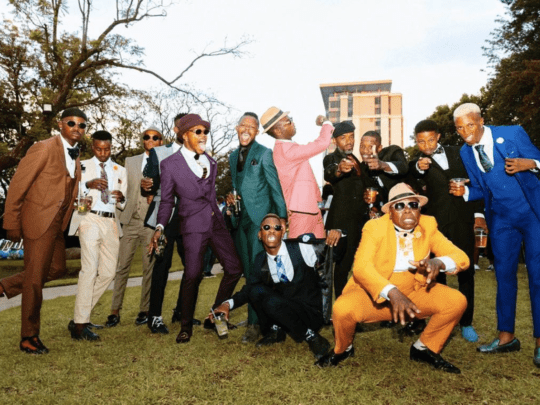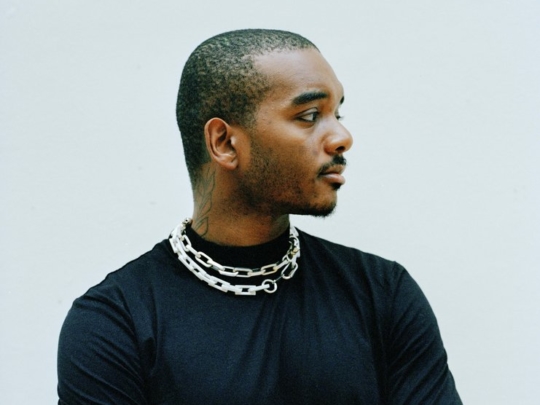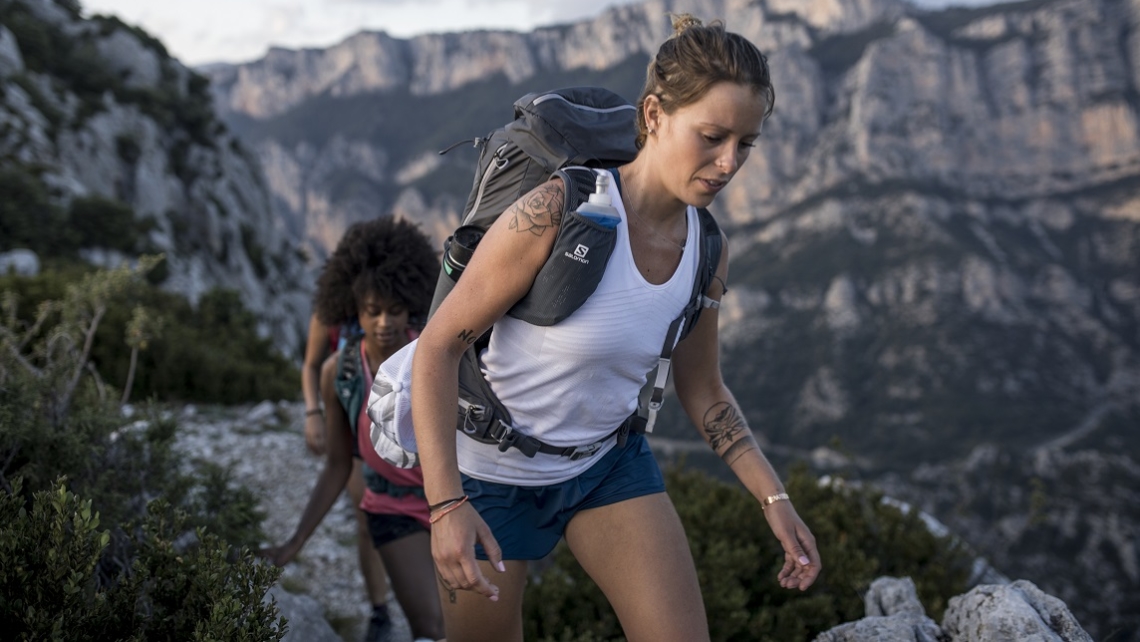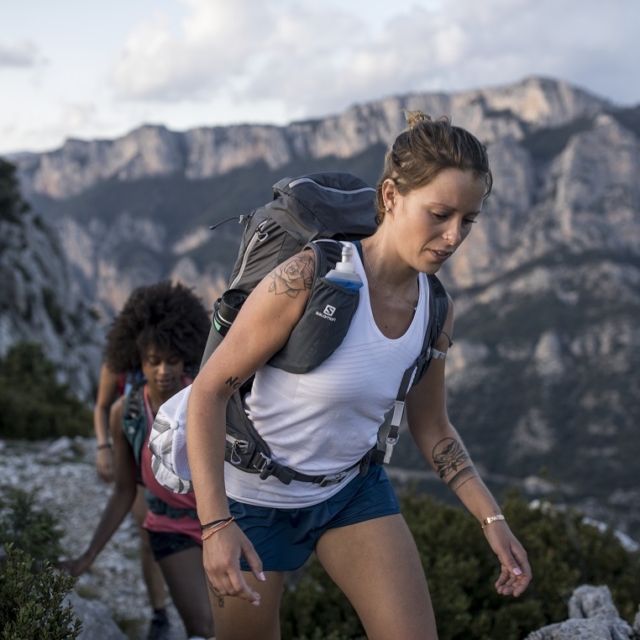As a post-pandemic culture takes shape, one trend is re-emerging. A new wave of designers, image makers and communities are embracing gorpcore – including outdoor active looks and the activities that they’re designed for. In short, out is in.
Gorpcore: it’s here to stay
Outdoor equipment and clothing companies, including Arc’teryx, Asics, Klättermusen, Nike’s ACG and Salomon, are trying to take the stylistic and cultural lead through collaborations, sharing the design credits with emerging collectives such as Athene Club, Flock.Together and GORPGIRLS.
Founded to protect nature, diversify greenspaces, champion the outdoors and bring communities together, these collectives are out to promote change, one adventure at a time. They’re collaborating with outerwear brands to offer sponsored opportunities and experiences in nature. Conscious creatives are conceptualising immersive, original and considerate visual content that showcases breathtaking terrains while putting equipment to the test.
The trend is reinforced through nature-focused Instagram accounts (such as @unownedspaces, @hikingpatrol and @114.index) with huge online presences. Content spreads through cyberspace at hyper-speed.
Coined by The Cut in 2017, Gorpcore fuses normcore with gorp, an acronym for the colloquial term for trail snack favourite, Good Ol’ Raisins and Peanuts. It describes a utilitarian style centred around practicality and functionality. It’s about a low-key wardrobe of staple pieces, discreet enough to fit into a compact backpack, that is worn time and time again.
Designed to compete with harsh weather, pieces are built from high quality, lightweight and weather-proof technical fabrics. Fits are loose for ease of movement; pockets and belt loops feature heavily to keep things close on the go. Reflectives increase visibility in adverse conditions. Colour schemes vary from earthy tones to vibrant hues depending on the purpose of the garment. Being noticeable is a given for safety in the mountains.
Many outerwear brands have long centred on nature. Patagonia is famous for its environmental action, donating 1 per cent of its annual income to environmental non-profits around the globe. Meanwhile, 94 per cent (and counting) of the brand’s products are made from recycled and renewable materials. Patagonia says ‘carbon neutral is not enough’ and promises to use its influence to meet the climate challenge with systemic change. Arc’teryx, Klättermusen, The North Face and Kathmandu are also making efforts to protect the planet.
The gorpcore trend has rapidly moved onto city streets. Ben Maher, founder of London-based designer and sportswear resale company PastDown.Store, reports that Arc [‘teryx] jackets, vintage ACG and Montbell pieces are selling out rapidly, adding that there is “a real scene for hiking gear at the moment”.
Searches on Lyst, the global shopping platform, reflect the trend. In late 2021, searches for pieces like the Arc’teryx Beta AR jacket, Patagonia zip-up fleeces and Salomon technical sneakers hit an all-time high, says Brenda Otero, formerly culture communications manager at Lyst.
Saeed Al-Rubeyi, co-founder of UK-based planet positive streetwear brand Story mfg, reflects on gorpcore. “There is a strange thing that is happening where dudes are dressing like they’re going on an expedition to the South Pole when actually they’re just going to Carnaby Street. The good thing is it’s got people more into outdoor gear. The bad thing is that everyone feels like they need an £800 jacket to go down a country lane when they could wear anything that they wear to the pub.”
As street style diehards catch wind of gorpcore, they naturally want to test out their new gear in the big outdoors. “People want to trial the functionality of their new outerwear, immersing themselves in the home of gorp gear, away from the churning cogs of the city,” says Maher. “The more immersed in nature we are, the more inclined we’ll be to make sustainable choices. Fashion-related or not.”
Al-Rubeyi agrees. “Exposure to the outdoors is always good. It’s good for your health. It’s good for you. Seeing something first-hand is always more powerful. If you see something beautiful, you’re going to want to preserve it… People who spend more time outdoors seem to be much more connected with nature, the planet and wider issues such as sustainability.”
Young designers support the thinking behind gorpcore. “It’s great when fashion isn’t just made to help us in nature but is also made to encourage us to engage with it. Great outerwear will push the wearer to face the forces of nature that are available, and through this, appreciate nature’s priority over us,” says menswear designer and Central Saint Martins graduate, Jimmy Howe.
Nature, quality and sustainability form the foundations of many emerging designers’ work. Howe finds that “nature and fashion fuse from usage and the need for protection against the elements. There is sustainability in longevity. I really hope this is something that is drawn from the ongoing appreciation of outerwear. Some of these jackets are made so beautifully, their attributes are what I would define as ‘luxury’ and their usability reflects their sustainability.”
He adds: “The planet cannot function anymore on single-use products like plastic bottles, straws and food packaging, as much as it cannot survive any longer with single-use clothing. The idea of buying something, no matter how it was made, to just wear it once, or once a year, is destructive. Pieces derived from functionality offer us incentive other than to just look good once.”
Arnar Mār Jōnsson and Luke Stevens, the Icelandic-British duo behind high fashion-outdoor fusion brand Arnar Mār Jōnsson, share a similar mentality. “Using nature as an element in all of our design processes makes it hard to overlook all the damaging factors that fashion is having on the environment,” says Arnar Mār Jōnsson, who graduated from the Royal College of Art in 2017.
Mār Jōnsson and Stevens are in search of natural alternatives to the harmful synthetic and plastic materials previously used for outdoor garments. After exploring the heritage of Icelandic cloth, the duo decided to work with Lopi, a water-resistant and insulating knitting wool made from the fleece of Icelandic sheep. They also experiment with plants to make natural dyes.
“If more brands start to think in such a way, this could have a positive impact on the products people are producing and their impact on the environment,” says Mār Jōnsson.
Fashion brands such as Jil Sander, Gucci and Jacquemus are vouching for gorpcore in the luxury realm with high fashion-meets-technical wear collaborations – fit for the metropolis and for the middle of nowhere.
As environmental pressures become overwhelming, a rethink is unequivocal. Where aesthetics and responsibility once sat at opposing ends of the spectrum, the great outdoors is inspiring a fusion. Through creative output, continued collaboration and innovation, gorpcore can act as a catalyst for sustainable design and careful consumption. Long may it endure.






